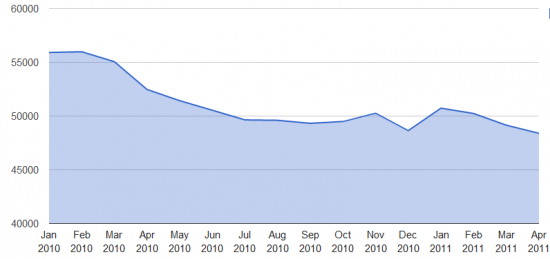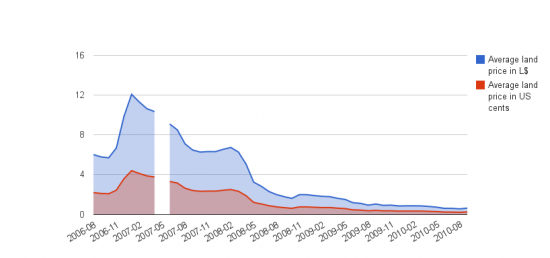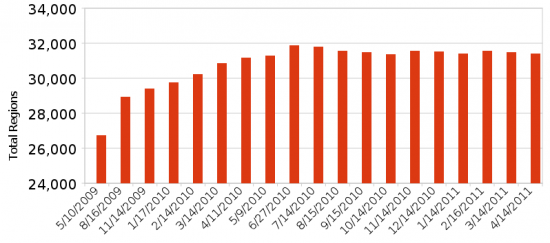Second Life is a tipping point, and has been precariously balanced there for months.
Average daily concurrency has been slipping since the start of 2010, according to data from Metaverse Business. In fact, according to Tateru Nino, concurrency in Second Life is at its lowest level in two years.

The price of land per square meter has fallen even further — from US 4.4 cents in January 2007 to US 0.24 cents in September 2010. That’s a loss of around 95 percent of its value. The price fall in Linden dollars is even steeper, from 12 L$ to 0.4 L$, but some of that is due to the changing Linden dollar exchange rate.
Linden Lab stopped publishing these metrics in October of 2010.

Meanwhile, the number of regions in Second Life has dropped eight of the last twelve months. Since last summer, Second Life has lost over 400 regions, according to data from Grid Survey.

The doomsday scenario
Second Life’s large real estate barons make their money by renting whole regions from Second Life, subdividing them, adding terrains and landscaping and other improvements, and renting out smaller parcels to end users.
Wagner James Au (known as “Hamlet Au” in Second Life) recently pointed out that Grid Survey data also shows that the top ten estates control 22 percent of Second Life’s land area — and the top 500 control 75 percent. That means that 500 land developers are responsible for 73 percent of Second Life’s $60 million of revenues that come from land sales. Au estimates that only $3 million comes from Linden Dollar sales commissions, premium account payments and other miscellaneous revenue channels.
So here’s the thought experiment.
Say you’re a successful land developer. You know how to improve and subdivide land, you know how to attract tenants, and you know how to make them happy. But it’s a competitive market — other landlords are doing the same things you are. Residents expect to get  more and more and pay less and less — but you’ve got your $295 per region to pay to Second Life each month — plus the $1,000 setup fee when you need to set up a new region. You also have to reserve some land for landscaping and other amenities, and a certain percentage of your available plots will be vacant each month due to routine customer turnover.
You will also need to hire support staff, community managers, or designers to provide the value-add services that your residents need. So you costs are steadily rising, but your rental income is dropping.
Meanwhile, if something goes wrong, you’re dependent on Second Life’s support system. You can’t restore a residential region from a backup, or ban people with particular IP addresses from renting or visiting your land.
Now, say you’ve got enough tenants lined up to buy another region, and you’re faced with spending $1,000 to set it up, plus whatever additional costs you incur for landscaping and other improvements.
Or, for $74 per month (45 pounds), and $41 (25 pounds) per region, you can set up a whole private grid in OpenSim with a provider such as PioneerX Estates. (They’ve got four week’s worth of backlog of new grid setups right now though, so you’d have to wait — or try one of their competitors, like Dreamland Metaverse or SimHost.) You’d spend the rest of your $1,000 on getting permissions from third-party creators to move their licensed content to the new grid.
PioneerX is currently running 3rd Rock Grid — read full story about this here. Their grid management package comes complete with in-grid currency, a website with land rentals and currency purchases and other functionality, automatic region restarts, full backups, the ability to easily add regions or move regions around or ban users or turn hypergrid on or off, and many other functions — more added on a regular basis. Grids that opt for the OMC multi-grid currency instead of setting up a private currency get a discount — as do grids that order many regions at once.
No technical skills are required to do this. The hosting provider takes care of the servers, the bandwidth, the backups, the upgrades — everything technical that goes into running a grid. This is similar to the way website hosting companies take care of all the webserver infrastructure, leaving you free to focus on website design and content.
Of course, not all Second Life features are available in OpenSim. For example, some high-end physics scripts might not work well, and voice in OpenSim is currently significantly inferior to what you get in Second Life, unless you get your private grid from the folks behind Avination — which has a license to set up Vivox voice for customers.
OpenSim grids are also missing the wide variety of events, content, and people who are in Second Life. Finally, OpenSim is still alpha software — upgrades regularly break hypergrid teleport compatibility, for example.
But there are some advantages to moving over. Texture uploads are free. The number of prims on a region is limited only by server capacity — for example, Kitely and ScienceSim both offer regions that can hold up to 100,000 prims. OpenSim also has megaprims, and no-border-crossings megaregions. Finally, hypergrid teleports allow users from one grid to visit another to attend events, meet friends, or go shopping, if the grid owners decide to enable this feature.
Today, the move already makes sense for small, tight-knit communities, such as members of a particular role-playing group.
As a grid owner, you would be able to offer your tenants a discount on land, and still make more money because your region costs are so much lower — and dropping steadily. Plus, if you have your own currency, you would also make money on currency sales and exchanges.
Avination and InWorldz have already demonstrated that it’s possible to do this, and make money at it.
Many OpenSim hosting companies are also contributing code back to OpenSim, as is Intel. The user experience, stability, and functionality is improving rapidly.
It has to sound tempting. As a grid owner, you’re your own boss. You’re not dependent on Second Life for your existence. You control the land market, the currency market, the on-grid content, the entire economy. Most importantly, you own your customers. Today, Linden Lab keeps track of customer accounts, their payment information, their preferences. As a grid owner, you get to ask for real-world payment information, for age verification, for their email addresses. After all, if something happens to Linden Lab — or your access to Second Life — you would lose access to all your customers.
It makes sense to at least dip a toe in. Leverage your existing customer relationships to start building your own grid, before something happens to those customers.
So let’s say you do that, and you start funneling some customers to OpenSim. Customers who can’t afford Second Life’s land prices. Customers who want a private, controlled environment. Or customers who are simply looking for something different.
These customers may decrease or completely eliminate their land holdings in Second Life, showing up just for events and socializing. But if your private grid catches on, then they will spend more time there, and bring their friends over to join them.
This, in turn, puts additional downward pressure on Second Life land prices — and squeezes your Second Life profit margins further, making OpenSim even more attractive to you, so you promote it a little more, and promote your Second Life offerings a little less.
Other land barons do the same.
The snowball effect has already begun in the educational community. As school after school flees Second Life’s land prices and adult content, private mini-grids are springing up, hosted both by commercial providers like ReactionGrid and SimHost, and run by the schools themselves, behind their firewalls.
One potential trigger for the snowball effect is OpenSim coming out of alpha, rolling out Hypergrid 2.0, and focusing on hypergrid compability.
With Hypergrid 2.0, grid owners will be able to decide whether content can leave their grids or not, and where it can go. Grids like Avination are already planning to turn on hypergrid when that happens.
With OpenSim out of alpha, the developers will have to focus more on backwards compability. Today, there are three different versions of the hypergrid protocol in use by OpenSim grids, making it extremely difficult to travel across the metaverse.
With better compatibility and security, hypergrid teleports will become more reliable and more tenable for closed, commercial grids.
This means that OpenSim will no longer be composed of small, isolated islands of users — but become one interconnected web of worlds.
Other hypergrid-related features in the works are cross-grid, hypergrid-enabled avatar profiles and groups, which will further help create a single social metaverse.
Why I don’t want Second Life to fail
I love OpenSim. But there’s a reason I call the snowball effect a “doomsday scenario.”
That’s because a stable, successful Second Life is critical to the metaverse.
The existence of Second Life, and the Second Life official viewer, creates a standard that all grids must compare against. The closer a grid is to Second Life, the easier it is for users to switch from one platform to another, to move content and scripts. OpenSim users can turn to Second Life tutorials, in-world classes, and other resources to learn how to move, how to build, and how to script.
The open source, volunteer-driven OpenSim community cannot hope to match the wealth of resources available because of Second Life.
Second Life is also the single largest marketing platform out there for OpenSim. It brings in anywhere between 10,000 and 17,000 new signups every day. The top 40 OpenSim grids combined are lucky if see that many new users in an entire month.
If Second Life is able to fix its retention problems, then many of these users will stay, learn to use the platform, and become potential customers for OpenSim grids and hosting companies.
Better yet, Second Life can become a portal to the metaverse, the same way that AOL eventually dropped its walls and embraced the Internet. By adding a new permissions setting — single grid or multi grid — and making it “single grid” by default, Linden Lab can short-circuit the laboriously slow open source development process and simply dictate a new security standard for all Second Life compatible viewers. By allowing Linden dollars to be used by OpenSim grid, it could become the defacto currency of the metaverse. (This would require a Web-based confirmation step for extra security, but many OpenSim payment mechanisms, including that of the OMC multi-grid currency, currently do just that and it works.)
By allowing multi-grid object deliveries, the Second Life marketplace could become the central shopping area for the metaverse. Linden Lab could make money no matter what grid users were on.
Now, personally, I don’t like this scenario any more than the doomsday one. I prefer a heterogeous metaverse, with different providers offering different functionality. On the web, I like going to one site for search, another site for news, and a third site for my email. I get to pick and choose the best provider in each category, instead of being stuck with whatever one company could come up with. After all, no single company can be the best at everything.
Today, however, Second Life could easily dominate its OpenSim rivals in currency, marketplaces, search, and many other functions.
The steady-state scenario
And there’s a third alternative to development, which I believe is most likely. OpenSim will continue to gain users and regions. Second Life will continue to just hold its own as it improves its functionality and interface, but will continue to remain separate from the rest of the metaverse.
Second Life’s isolation will allow OpenSim startups to flourish. Hosting companies, content vendors, currency vendors, search providers and many more will get a chance to make their mark without fear of competition from Second Life.
Eventually, OpenSim will come out of beta and roll out Hypergrid 2.0, and adoption will start to climb. After a couple of years, Second Life will be forced to drop its walls, but it will no longer be doing it on its own terms, and will not be able to influence the future path of OpenSim development.
It will drop its prices, and maybe scrap its proprietary platform entirely for OpenSim, just as AOL eventually got rid of its own user interface and switched over to HTML.
It doesn’t necessarily mean that Second Life will eventually have to shut down. After all, AOL is still around. But it will have to switch over to maintenance mode, ceasing investment in new technology and focusing on just keeping existing users happy enough  so that they’ll stay.
I don’t agree with Au that Second Life needs a mass influx of new users to stay alive. Every fast-growing company has had to, at some point in its existence, transition to being a mature, slow-growth company. It’s a fact of life — markets get saturated. You can’t keep a hockey stick curve running straight up for ever.
Just like AOL did, Second Life will have to cut back on investments in technology, switch to a more competitive pricing structure, and focus more on the needs of its customer community. Instead of being a cutting-edge technology company, it will have to recreate itself as a community-oriented platform. That might entail an identity crisis, but if Second Life gets past it, it can continue on for a long, long time.
- OSgrid back online after extended maintenance - April 16, 2025
- Analysts predict drop in headset sales this year - March 25, 2025
- OSgrid enters immediate long-term maintenance - March 5, 2025
